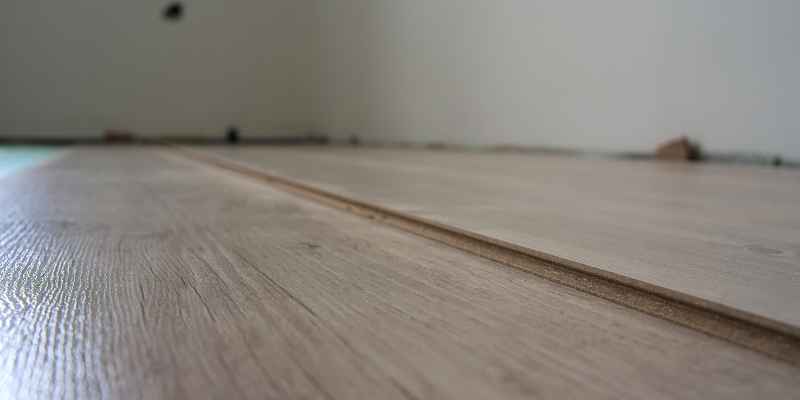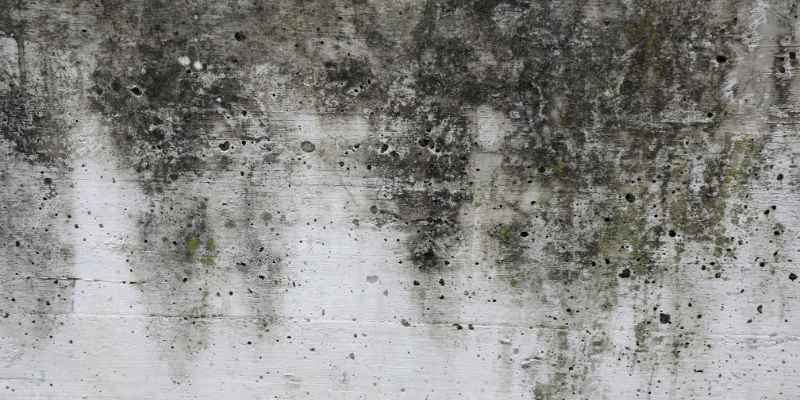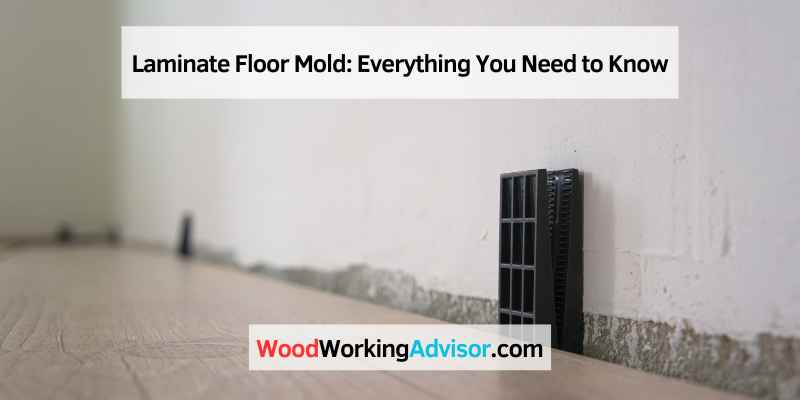Mold can grow under laminate floors due to water damage, leading to dampness or excessive moisture buildup. If water penetrates the seams or edges of the laminate planks, it creates a suitable environment for mold growth.
Laminate flooring is a popular choice for homeowners due to its durability, affordability, and ease of installation. However, it’s essential to be aware of the potential risks of mold growth under laminate floors. Water damage can penetrate the seams or edges of the laminate planks, creating an ideal environment for mold to grow.
Mold under laminate flooring can cause various health problems and weaken the structural integrity of floors. Therefore, it’s crucial to detect mold growth as early as possible and take remedial measures. We’ll discuss in detail how to find and fix mold under laminate flooring.
Causes Of Laminate Floor Mold
Excessive moisture buildup is the main cause of laminate floor mold. Water damage from leaks or spills can penetrate the seams or edges of the laminate planks, leading to the growth of mold underneath. Discoloration or dark spots on the flooring can be a clear indication of mold buildup.
Laminate floors are an excellent option for homeowners who want to achieve the look and feel of hardwood without the high cost. However, as with any flooring type, they can be susceptible to mold growth. Mold under laminate flooring is caused by dampness or excessive moisture buildup. To prevent or address this problem, it is important to understand the causes of laminate floor mold, which can be grouped into three main categories: moisture buildup, water damage, and underlayment and subfloor issues.
Moisture Buildup
Moisture buildup is one of the primary causes of laminate floor mold. This occurs when there is excessive humidity or poor ventilation in your home, leading to condensation or moisture buildup on your floors. Common culprits include excess moisture from cooking or showering, foundation leaks, or high humidity in basements or crawl spaces. The excessive moisture can seep through the seams of the laminate flooring and create the ideal breeding ground for mold to thrive. If left unchecked, this can compromise the structural integrity of your floors, making it imperative to address as soon as possible.
Water Damage
Water damage is another common contributor to mold growth under laminate flooring. Whether from leaking pipes, overflowing tubs, or severe weather conditions, water damage can seep under the laminate flooring and create a breeding ground for mold. The longer the water sits, the greater the risk of mold growth. Therefore, it is essential to address any water damage as soon as possible to prevent mold from developing or spreading.
Underlayment And Subfloor Issues
In many cases, laminate flooring is installed over a subfloor or underlayment that may not be suitable or correctly installed. If the underlayment is not moisture-resistant or was not installed correctly, or if the subfloor is uneven, this can lead to gaps or spaces between the laminate planks. These gaps can trap humidity or moisture, providing the perfect environment for mold growth. It is important to ensure that your underlayment and subfloor are appropriately installed and that any gaps or spaces between the laminate planks are adequately addressed to prevent mold growth.
In summary, laminate floor mold is a common problem that can compromise the structural integrity of your floors and impact your health. It is essential to understand the causes of laminate floor mold, including moisture buildup, water damage, or underlayment and subfloor issues. Addressing these issues as soon as possible can prevent mold from taking over your floors and keeping your home healthy and safe.

Signs Of Laminate Floor Mold
Discoloration or dark spots on your laminate flooring can be a clear sign of mold. This can indicate excessive moisture buildup and dampness, which can lead to the growth of mold underneath. It is important to address any water damage or leaks promptly to prevent the growth of mold under your laminate flooring.
As a homeowner, discovering mold growth in your home can be a worrying and stressful experience. Mold not only damages the integrity of your laminate flooring but also poses a risk to your health. Mold grows in the presence of moisture, and laminate flooring is not immune to moisture damage. In fact, laminate floors are at a higher risk of mold growth because they are often installed in high-traffic areas such as kitchens and bathrooms. Fortunately, there are signs to look out for to detect mold growth in your laminate floors.
Discoloration
Discoloration on your laminate floors is one of the most common signs of mold growth. Dark patches or spots on your floors indicate the presence of mold. These patches may be green, black, or brown, and they can appear in any area of the room. Discoloration occurs when moisture penetrates the seams and edges of the laminate flooring and provides a suitable environment for mold growth.
Musty Smell
Another sign of laminate floor mold is a musty odor in the room. Mold produces a distinct smell that is often described as earthy, damp, or musty. The odor may be faint or overpowering, depending on the severity of the mold growth. If you notice an unusual smell in your home, it is advisable to investigate as it could be a sign of mold growth.
Visible Mold Growth
Visible mold growth is a clear sign of mold infestation in your laminate flooring. Mold can grow underneath the flooring or on its surface, and it appears as fuzzy or slimy growth. Mold growth on the surface is easy to detect, but detecting mold underneath the flooring may require professional assistance. Visible mold growth indicates that the mold has been growing for some time and requires immediate attention to prevent further damage.
In conclusion, regular inspection of your laminate floors can help detect mold growth early before it causes significant damage. Keep an eye out for discoloration, musty smell, or visible mold growth. If you suspect mold growth in your home, it is advisable to contact a professional mold removal service to handle the problem.
Health Risks Of Laminate Floor Mold
Moisture buildup or dampness can cause mold growth under laminate flooring, posing serious health risks. Discoloration or dark spots on the floor may indicate the presence of mold, which needs immediate attention to prevent potential health hazards. Take necessary precautions and seek professional help to handle mold-related problems in your laminate flooring.
Laminate flooring has become popular in the United States due to it being affordable, durable, and easy to clean. However, one thing people do not realize is that it is susceptible to mold growth. The growth of mold can cause health problems, especially if left untreated. In this article, we will take a closer look at the health risks associated with Laminate Floor Mold.
Allergies
The presence of mold spores in the air can lead to various allergic reactions. Mold allergies can show symptoms such as sneezing, runny nose, itchy eyes, skin rash, and asthma. Those who suffer from allergies are more susceptible to these symptoms and may find it hard to breathe.
Respiratory Problems
Inhalation of mold spores can cause respiratory problems such as bronchitis and pneumonia. It can also trigger asthma attacks, especially for those who are already suffering from it. Long-term exposure to mold can lead to permanent lung damage, which could be life-threatening.
Prevention
It is essential to prevent mold growth from the beginning. One way to do this is to keep moisture away from the floors as much as possible. Clean up any spills or leaks immediately, especially when they happen around the edges of the laminate flooring. If there is water damage, ensure you thoroughly dry the area.
Conclusion
To ensure your well-being, it is crucial to address mold growth on your laminate flooring promptly. If you are experiencing any health problems mentioned above, seek medical help as soon as possible. Keep in mind that prevention is better than cure; therefore, taking steps to prevent mold growth from happening is the most effective solution.
Prevention Of Laminate Floor Mold
Water damage poses a significant risk to laminate flooring as it can lead to the growth of mold underneath. Mold under laminate flooring is caused by dampness or excessive moisture buildup. Discoloration or dark spots on your laminate flooring can be a clear sign of mold.
Laminate flooring has become a popular choice due to its durability, affordability, and attractive appearance. However, it is vulnerable to mold growth, especially in areas with high humidity or moisture. Mold growth can cause health problems if not addressed promptly. Therefore, it’s crucial to take preventive measures to keep mold at bay. In this article, we’ll discuss some effective ways to prevent mold growth on laminate floors.
Regular cleaning and maintenance
Regular cleaning and maintenance should be part of your daily routine. Dust or sweep the floor, mop it with a damp cloth, and allow it to dry. It’s important to avoid using excessive water when cleaning the laminate floor, as water can seep into the cracks, causing mold growth. Also, avoid using harsh chemicals that can damage the floor’s surface and lead to mold growth.
Proper installation techniques
Proper installation is crucial to prevent water from seeping into the flooring’s seams and edges. It’s essential to hire a professional to install the laminate floor properly. A professional installer will ensure that the subfloor is level and free of moisture. They’ll also use a moisture barrier to prevent water from seeping into the flooring.
Moisture control
Moisture control is key to preventing mold growth on laminate floors. Ensure that the humidity levels in your home are kept low; use dehumidifiers in areas with high humidity levels, such as bathrooms and basements. If there are any leaks or spills, clean them up promptly to prevent water from seeping into the flooring. Also, avoid placing potted plants directly on the floor, as water can seep into the flooring and cause mold growth.
In conclusion, by following these preventive measures, you can significantly reduce the risk of mold growth on your laminate floors. Regular cleaning, proper installation, and moisture control can go a long way in keeping your laminate floors mold-free. If you notice any signs of mold growth, such as a musty smell or discoloration, take immediate action to prevent its spread.
How To Remove Laminate Floor Mold
Mold can grow underneath laminate flooring if there is excessive moisture or dampness buildup. It can be detected by dark spots or discoloration on the flooring. To remove laminate floor mold, it is important to identify and fix the source of moisture, remove any damaged flooring, and thoroughly clean and disinfect the affected area.
Mold growth can be a daunting experience for any homeowner, particularly when it is found on laminate flooring. As a result, it is important to know how to remove laminate floor mold effectively. Before you start the process, begin by determining the extent of mold growth, taking adequate safety precautions, and then proceeding with the removal and disposal of affected laminate planks. In this blog post, we’ll delve into how you can safely and effectively remove mold from your laminate flooring.
Determining Extent Of Mold Growth
Before you start the removal process, it is important to determine the extent of mold growth on your laminate flooring. If the growth is limited to a small area, you may be able to remove it yourself. However, if the mold has spread to a larger area, it is recommended that you seek professional help from an expert mold remediation company.
Safety Precautions
It is important to take safety precautions when dealing with mold growth, as it can release harmful spores. Make sure that you wear protective gear such as gloves, dust masks, and goggles. Additionally, seal off the affected area to prevent mold spores from spreading to other areas of your home.
Removal And Disposal Of Affected Laminate Planks
Once you have taken the necessary safety precautions, it is time to remove the affected laminate planks. Begin by using a utility knife to cut out the affected area, making sure to cut out a section wider and longer than the visible mold growth. Carefully remove the planks by lifting them up and cut them into smaller sections for ease of disposal. Bag the affected laminate planks and discard them appropriately.
In conclusion, removing mold from laminate floors can be a daunting task, but it is necessary to ensure the health and well-being of your family. By following the above steps, you can safely and effectively remove mold from your laminate flooring.
Professional Mold Removal Services
If you’re dealing with laminate floor mold, it’s important to seek out professional mold removal services to properly address the issue. Excessive moisture buildup or water damage can lead to mold growth underneath laminate floors, which can cause discoloration or dark spots on the surface.
All Nation Restoration offers insurance-friendly mold treatment services in Austin, Texas.
underneath concrete or other types of flooring), which makes them susceptible to growth of mold if not properly protected from moisture. Professional mold removal services are sometimes necessary to eliminate this problem.
When To Consider Professional Help
If you notice any signs of mold growth under your laminate flooring, such as discoloration, odors, or visible mold patches, it’s important to get professional help right away. Mold can cause serious health problems if left unchecked, and can also compromise the structural integrity of your flooring if it spreads too far.
What To Expect From Mold Removal Professionals
Professional mold removal services typically start with a thorough inspection of the affected area to determine the extent of the damage. The experts will identify the type of mold growing under your laminate flooring and come up with a customized plan to remove it.
The next step is to contain the affected area to prevent the spread of mold spores and protect the rest of your home from contamination. Special equipment is used to remove the mold, such as air scrubbers, dehumidifiers, and negative air machines.
After the mold has been removed, the experts will make sure that the area is thoroughly cleaned and sanitized. Depending on the amount of damage, some parts of your flooring may need to be repaired or replaced.
Overall, it’s important to hire professional mold removal services to make sure that the mold is completely removed and the affected area is properly cleaned and restored. This will ensure that your home is safe and healthy for you and your family.

Frequently Asked Questions Of Laminate Floor Mold
Can Mold Grow Under Laminate Floors?
Yes, mold can grow under laminate floors if water penetrates the seams or edges of the laminate planks. Water damage from leaks, spills, or floods poses a significant risk to laminate flooring and can lead to the growth of mold underneath.
Mold under laminate flooring is caused by dampness or excessive moisture buildup.
How Do You Get Mold Out Of Laminate Flooring?
Mold can grow under laminate flooring due to water damage, which can create a risk. To get rid of mold on laminate flooring, identify the source of moisture and fix it. Clean with a mixture of vinegar and water, and dry thoroughly.
In severe cases, consult a professional for mold removal.
Can Mold Grow Under Vinyl Plank Flooring?
Yes, mold can grow under vinyl plank flooring due to trapped moisture, which cannot escape through the non-breathable vinyl material. Laminate flooring poses the same risk when water seeps through the seams or edges of the planks, leading to mold growth underneath.
Detection and immediate action are necessary for remediation.
What Happens If Moisture Gets Under Laminate Flooring?
If moisture gets under laminate flooring, it can lead to the growth of mold underneath. Water damage can cause the board to swell and damage the bond between the top layer and the HDF board. If this happens, the affected laminate flooring will need to be replaced.
Discoloration or dark spots on the flooring can also be a sign of mold.
Conclusion
Laminate floor mold can cause serious health hazards if not addressed promptly. It is crucial to identify and fix the issue as soon as possible to avoid further damage to both the flooring and the health of residents. Regular maintenance, proper ventilation, and waterproofing can prevent the growth of mold under laminate flooring.
In case of water damage or noticeable signs of mold, professional help should be sought to ensure effective, safe, and long-lasting solutions. Taking these measures can ensure healthy, mold-free environments and extend the life of laminate flooring.


